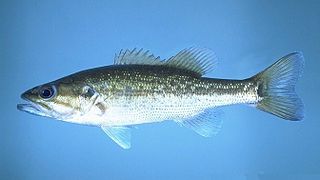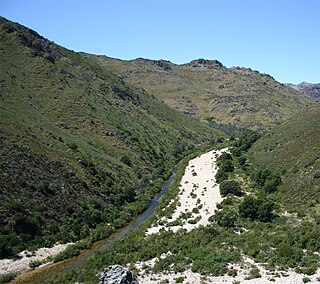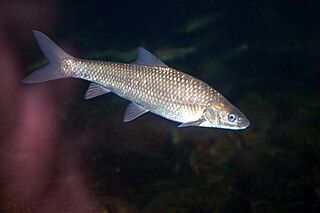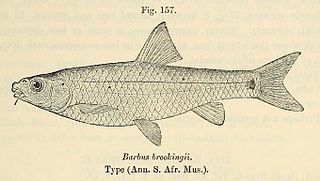
The spotted bass, also called spotty, or spots in various fishing communities, is a species of North American freshwater fish belonging to the sunfish family (Centrarchidae) of the order Perciformes. It is noted for the rows of dark spots below the lateral line, which give it its common name. One of the black basses, it is native to the Mississippi River basin and across the Gulf states, from central Texas through the Florida panhandle. Its native range extends into the western Mid-Atlantic states and it has been introduced into western North Carolina and Virginia. It has also been introduced to southern Africa, where it has become established in some isolated waters as an invasive species.

The Olifants River is a river in the northwestern area of the Western Cape Province of South Africa. The upper and main catchment area of the Olifants river is around Ceres and the Cederberg mountains. The Clanwilliam and Bulshoek dams are located on the river and provide water for the towns and farms along the watercourse. The river is approximately 285 km long with a catchment area of 46,220 km2 and flows into the Atlantic Ocean at Papendorp, 250 km north of Cape Town.

The Berg River is a river located just north of Cape Town in the Western Cape Province of South Africa. It is approximately 294 km (183 mi) long with a catchment area of 7,715 km² (2979 mi²) and debouches into the Atlantic Ocean. About 65% of the Berg River area is under agriculture. The major towns in the Berg River area are Velddrif and Laaiplek near the coast, Piketberg, Hopefield, Moorreesburg and Darling further inland.

Pseudobarbus is a ray-finned fish genus in the family Cyprinidae. The type species is Burchell's redfin. The scientific name is derived from the Ancient Greek pseudes ("false") and the Latin word barbus. This genus contains some of the South African redfins. It was originally proposed as a subgenus, but has since been found worthy of recognition as a full genus.

The Cape whitefish or Berg-breede River whitefish is a ray-finned fish species in the family Cyprinidae. It is placed with the South African redfins in Pseudobarbus. It is tetraploid. Its closest living relative was at one time considered the sawfin.
The Clanwilliam redfin, is a ray-finned fish species in the family Cyprinidae. It is placed with the South African redfins in Pseudobarbus. It is tetraploid. Its closest living relative is probably the Twee River redfin.

The Clanwilliam yellowfish is a ray-finned fish species in the family Cyprinidae. It has long been placed in Barbus, the "wastebin genus" for barbs, by default; however, the species is increasingly being restored to related yellowfish genus Labeobarbus which seems a much more appropriate placement. It is hexaploid like the other yellowfish, among which it is more closely related to the smallscale yellowfish than to the largescale yellowfish.
The Twee River redfin or simply Twee redfin is a ray-finned fish species in the family Cyprinidae. It is placed with the South African redfins in Pseudobarbus. It is tetraploid. Its closest living relative is probably the Clanwilliam redfin.
The sawfin, also known as Clanwilliam sawfin, is a ray-finned fish species in the family Cyprinidae. It is placed with the South African redfins in Pseudobarbus. It is tetraploid. Its closest living relative is probably the Cape whitefish.

The Eastern Cape redfin is an African freshwater fish species in the family Cyprinidae, this appears to be a species complex rather than a single species.

The smallscale redfin is a freshwater fish in the family Cyprinidae which is endemic to South Africa. It is threatened by habitat destruction and the impact of invasive species.

Burchell's redfin, also known as the Tradouw redfin, Tradou redfin or Breede redfin, is an African freshwater fish species in the family Cyprinidae. P. burchelli is the type species of its genus Pseudobarbus, and like all of these is tetraploid. The Berg River redfin is a very close relative.
The Berg River redfin or Berg redfin is an African freshwater fish species in the family Cyprinidae. The Burchell's redfin, the type species of its genus Pseudobarbus, is a very close relative. The Berg River redfin is tetraploid.
The Maluti redfin is a ray-finned fish species in the family Cyprinidae. It is colloquially called the Maluti minnow, but it is not a true minnow.

The slender redfin is an African freshwater fish species in the family Cyprinidae.

The border barb is a ray-finned fish species in the family Cyprinidae. It is placed with the South African redfins in Pseudobarbus. Like Pseudobarbus. It is tetraploid.
Verlorevlei River is a river in the Western Cape province of South Africa. Lying on the Sandveld of the West Coast, the river runs past Eendekuil, Het Kruis, and Redelinghuys. The river mouth is located at Elands Bay. Its tributaries include the Hol River, Kruismans River and the Krom Antonies River. It falls within the Drainage system G and the Management Area.

The Verlorenvlei redfin is a species of barb endemic to the Verlorenvlei River in South Africa.











